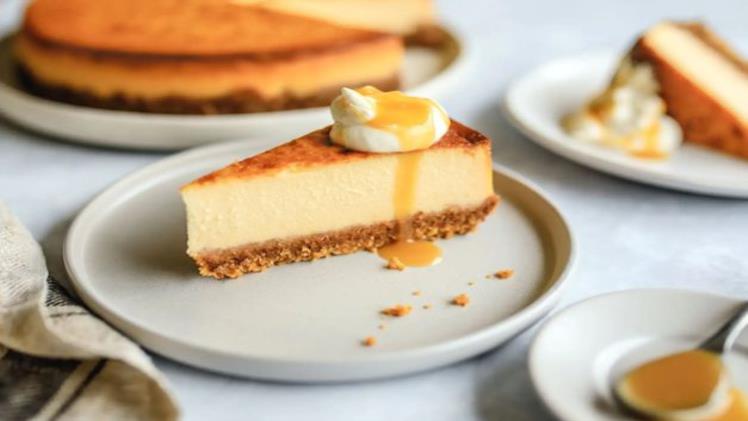How to Make the Perfect Cheesecake at Home?

Cheesecake is one of the most beloved desserts worldwide, known for its creamy texture and rich flavor. However, making a perfect cheesecake at home can be tricky. Many bakers and pros may encounter issues such as cracks, sinking centers, grainy texture, or soggy crusts. The good news? Most cheesecake problems have simple fixes. Here’s a complete guide on what can go wrong and how to prevent it, ensuring your homemade cheesecake turns out flawless every time.
Here are some common issues in cheesecake making:
Cracked Cheesecake Surface
Why does it happen?
-
Overbaking the cheesecake
-
Rapid temperature changes (cooling too fast)
-
Overmixing can cause too much air in the texture
How to prevent it:
-
Bake low and slow: Use a moderate oven temperature (around 325°F or 160°C) and bake the cheesecake until the edges are set but the center still jiggles slightly. Overbaking causes the surface to dry and crack.
-
Use a water bath: Wrapping the springform pan in foil and placing it in a larger pan filled with hot water helps regulate the baking temperature and keeps the cake moist.
-
Mix gently: Avoid whipping too much air into your batter by mixing just until smooth.
-
Cool gradually: After baking, leave the cheesecake in the turned-off oven with the door slightly open for about an hour before moving it to room temperature, then refrigerate. This gradual cooling reduces cracking.
Sinking or Collapsing Cheesecake Center
Why does it happen?
-
Opening the oven door too early or too often
-
Underbaking (removing the cheesecake too soon)
-
Using cold ingredients
-
Too much liquid in the batter
How to prevent it:
-
Don’t open the oven door early: Sudden temperature changes can cause the cake to deflate.
-
Check for doneness carefully: The cheesecake should be mostly set on the edges but still have a slight wobble in the center. It will firm up during cooling.
-
Use room temperature ingredients: This ensures the batter mixes evenly and bakes uniformly.
-
Measure liquids accurately: Too much sour cream, heavy cream, or other liquids can weaken the structure.
Grainy or Lumpy Texture
Why does it happen?
-
Using cold cream cheese or ingredients
-
Overmixing or undermixing the batter
-
Using low-quality or low-fat cream cheese
How to prevent it:
-
Bring cream cheese to room temperature: Softened cream cheese blends more smoothly without lumps.
-
Mix properly: Beat ingredients until smooth, but avoid overwhipping, which can break down the batter.
-
Choose full-fat cream cheese: It creates a creamier, silkier texture. Note that using a high-quality cheese matters a lot, so if you are buying cheese online, make sure you read every review about it.
Soggy or Soft Crust
Why does it happen:
-
Not baking or chilling the crust enough before adding the filling
-
Using too much butter or liquid in the crust
-
Filling leaks into the crust during baking
How to prevent it:
-
Press crust firmly: Make sure the crust is evenly and tightly packed into the pan.
-
Pre-bake the crust: Bake the crust for about 8-10 minutes before adding the filling to set it and reduce sogginess.
-
Use the right butter-to-crumb ratio: Enough butter to bind the crumbs but not so much that it becomes greasy or soggy. Remember that butter quality is the key, so the butter price is not important, but the quality is.
-
Cool crust before filling: Let the crust cool slightly after baking before pouring in the batter.
Cheesecake Sticking to the Pan
Why does it happen?
-
Not properly greasing or lining the pan
-
Using a springform pan with an uneven seal
How to prevent it:
-
Grease the sides of the pan well: Use butter or non-stick spray to prevent sticking.
-
Use parchment paper: Cut a circle to line the bottom of the pan.
-
Use a quality springform pan: Ensure it closes tightly and doesn’t leak.
Cheesecake is Too Dense or Heavy
Why does it happen?
-
Overmixing batter, incorporating too much air
-
Using too much flour or cornstarch (if added)
-
Overbaking
How to prevent it:
-
Mix just enough: Combine ingredients thoroughly but avoid excessive beating.
-
Use recommended stabilizers sparingly: If your recipe calls for flour or cornstarch, follow amounts precisely.
-
Bake carefully: Avoid overbaking to keep a smooth, creamy texture.
Off or Sour Flavor
Why does it happen?
-
Using expired dairy products
-
Using incorrect ingredients or proportions
-
Overfermentation of sour cream or cream cheese
How to prevent it:
-
Use fresh, high-quality ingredients: Check expiration dates on cream cheese, sour cream, and heavy cream.
-
Follow recipe measurements: Avoid substituting ingredients without considering the impact on taste and texture.
-
Store ingredients properly: Keep dairy refrigerated until use.
Tips To Have A Perfect Cheesecake Every Time
-
Room temperature is key: Always soften cream cheese, eggs, and dairy for a smooth batter.
-
Use a kitchen scale: For accuracy in measuring ingredients, especially dry ones.
-
Avoid plastic beaters: Use metal or silicone beaters to prevent plastic taste or residue.
-
Run a knife around the edge after baking: Loosen the cake gently before cooling to prevent cracks caused by shrinkage.
-
Chill long enough: Refrigerate cheesecake for at least 4 hours or overnight to set properly.
Cheesecake baking requires patience and attention to detail, but with these tips, you can avoid the most common pitfalls and bake a smooth, creamy, and beautifully set cheesecake. Remember: temperature control, gentle mixing, gradual cooling, and quality ingredients are your best friends in achieving cheesecake perfection.




